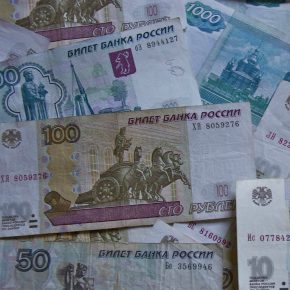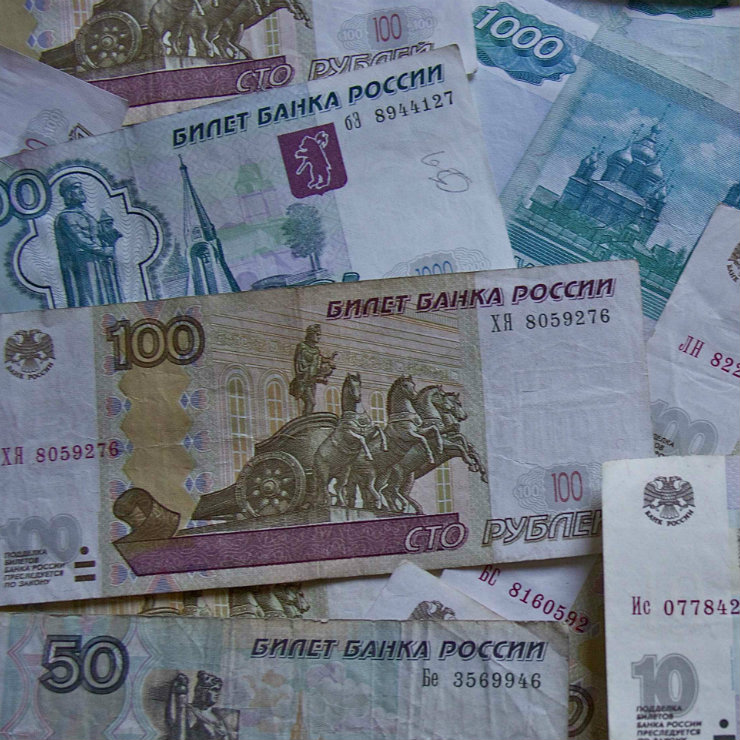Tydzień w gospodarce
Category: Trendy gospodarcze

(Martha de Jong-Lantink, CC BY-NC-ND)
However, the slow recovery of the Russian currency was abruptly halted by the imposition of new US sanctions against Russia. At the peak of the RUB crash in April, the Russian national currency fell to over RUB65/USD. At first sight, such a sudden drop in the value of the RUB might appear to be damaging to the Russian economy, but, from the point of view of Russia’s Finance Ministry, things are not as cloudy as it might seem.
The RUB has been extremely volatile in recent years, as it has followed the even more unstable oil prices around over the graph paper. Such volatility causes numerous problems, including making any budgetary planning very difficult. To tackle those issues, the Russian Finance Ministry has been devising sophisticated schemes to make the future value of the Russian currency more predictable.
Thus, “predictability” has become the new mantra of the liberal Kremlin faction that runs Russia’s finances, and the government has been trying hard to do something about the instability in RUB exchange rate.
Earlier this year, the Russian Ministry of Finance released a plan to use Russia’s oil and gas revenues to buy and sell foreign currency in the domestic foreign exchange market, in compliance with the so-called “fiscal rule” that has been reintroduced now, when the country’s economic crisis is receding.
The rule means excess revenues earned from raw material exports is sterilized in the fund so it can’t force the appreciation of the currency. “And the effect is already visible on the exchange rate dynamics as the correlation between the RUB and the cost of a barrel of oil has already been considerably weakened,” says Oleg Kouzmin, chief economist at Renaissance Capital.
That also means the Central Bank of Russia (CBR) is getting back into the foreign exchange markets, partly to implement the rule, partly to smooth out the fluctuations somewhat and partly as the central bank says that it wants to build up gross international reserves (GIR) to USD500bn over the medium term from the USD450bn reserves it started this year with. And if at all possible, the Kremlin would prefer an export-boosting weak ruble, according to hints dropped by President Vladimir Putin last year.
“The expected volume of oil and gas revenues in the federal budget in excess of the oil price baseline (USD40) in February 2018 is projected at RUB298bn (USD5.3bn). This sum will be used for foreign currency purchases. The financial interventions will start on February 7, 2018 and will go on until March 6, 2018. During that period, RUB15.7bn will be spent daily. The acquired foreign currency will be credited to the accounts of the Federal Treasury at the Bank of Russia,” a CBR statement said in February.
The financial interventions were supposed to continue from April until May, with daily purchases of RUB11,5bn. However, after the freefall of the RUB triggered by the US sanctions, the Ministry decided to temporarily suspend the foreign currency purchases. After a short pause, the interventions were restarted on May 18, with RUB17,5bn spent on foreign currency purchases.
The Russian Finance Ministry returned to the fiscal rule back in February 2017, when it began purchasing foreign reserves from oil and gas revenues exceeding the oil price baseline. With oil prices averaging around USD55 per barrel, the Ministry spent RUB113bn on foreign currency markets last February. Overall, during 2017, Russia spent RUB830bn, for which it was able to purchase USD14bn. Over time, with the growing oil prices, these purchases have been growing in significance. The ministry reached a record-high volume of purchases of RUB257bn in January this year, only to add another RUB40bn in February. If the price of oil stays above USD60 per barrel, the ministry will spend around RUB2.8 trillion this year, three-times more than last year.
That said, in addition to purchasing foreign currency and putting it into a special ring-fenced central bank account, last year the Finance Ministry was selling money from Russia’s Reserve Fund to finance the budget deficit – a process that came to an end in January, when the Reserve Fund was exhausted.
The double-edged policy neutralized the effect that the foreign currency purchases had on the ruble’s valuation. Whatever remained in the Reserve Fund has since been merged with the National Welfare Fund, a second fund established to cover pension payments in the mid-term.
This means that this year’s record-breaking foreign currency purchases by Russia’s Finance Ministry are no longer accompanied by the opposing force in the form of foreign currency sell-outs. According to some Russian analysts, this new situation could seriously influence the RUB/USD exchange rate.
“Such a high volume of foreign currency purchases will have a cumulative negative effect on the ruble exchange rate. According to our estimates, the ruble will lose 5-6 per cent of its value against the USD,” Vladimir Kiselev, financial analyst from the investment company Dokhod, said in an interview.
From a longer-term perspective, the ruble remains a highly volatile currency. In 2014, USD1 was equal to around RUB35. Two years later, in 2016, it dropped to RUB82. At the end of 2017, the USD/RUB exchange rate was around RUB60, only to appreciate against the USD to around RUB56 in February this year and drop down to RUB65 in mid-April.
This level of volatility has attracted many FX traders seeking short-term profits. It took a mere two months (November 2017 to January 2018) for the RUB to appreciate by around 8 per cent against the USD. And, according to many observers, it can take just as little time for the RUB to get back to its last November’s levels.
Already before the latest round of the US sanctions, and the subsequent decline in the value of the Russian currency, most analysts expected to see a RUB depreciation. According to VTB Capital, the USD/RUB exchange rate will average around RUB60.7 to the USD in the first quarter of 2018. Aton Capital’s macro analysts see the exchange rate averaging around RUB61-RUB62 throughout this year. In general, a weaker RUB is negatively affecting Russian companies selling products locally in domestic currency, but it benefits Russian exporters.
But now the authorities want to take the currency in hand. Earlier this year, Russia’s Finance Minister Anton Siluanov said that the ministry is prepared to do whatever it can to prevent the Russian currency from appreciating.
“Oil prices have gone up, the RUB is getting stronger, but we have already began to carry out financial operations involving the purchase of foreign currency under the fiscal rule. We won’t allow the RUB to appreciate,” Siluanov said at the Gaidar Forum in Moscow in January.
According to the minister, Russian business suffers from ruble appreciation, as it becomes less competitive on the global markets. “The fiscal rule implementation will also bring a lot of reserves for the federal budget. This year, we expect revenues from oil and gas worth of 3 per cent of GDP to go to the reserves,” he added. With Russia’s GDP in 2018 projected at RUB1.52 trillion, 3 per cent would amount to RUB45bn.
This year’s fiscal rule is Russia’s third attempt at decoupling the value of the RUB from the price of oil and turn Russia into “the second Norway”, as Russia’s Finance Minister Siluanov likes to put it.
The third rule is different from the previous two as it provides a higher degree of predictability to medium-term budgeting. Older rules were based on historical oil prices, but the new one determines the amount of revenues available to the federal government for spending by a fixed oil price benchmark (USD40 per barrel in 2017 prices). „We have economic stability again,” Siluanov said at the Gaidar Forum. „Now we need predictabililty.”
And unlike in previous years, when the RUB/USD exchange rate largely copied the price of a barrel of oil, the correlation between those two values has been weakening. The price of a barrel of brent crude oil has been steadily growing since February 2018, going up from USD62 per barrel to the current USD73 per barrel. During the same period, the Russian currency has been weakening against the USD, going from RUB56 for USD1 to the current RUB64.5 for USD1.
The US sanctions that affected Russia’s arms seller Rosoboronexport, Russian Financial Corporation and the country’s biggest aluminum producer Rusal, as well as Gazprom CEO Alexei Miller, VTB CEO Andrei Kostin, Renova owner Viktor Vekselber, or Oleg Deripaska, aided the Russian Finance Ministry in achieving its goal of weakening the Russian currency and decoupling its value from the price of oil.
Filip Brokeš is an analyst and a journalist specializing in international relations.

